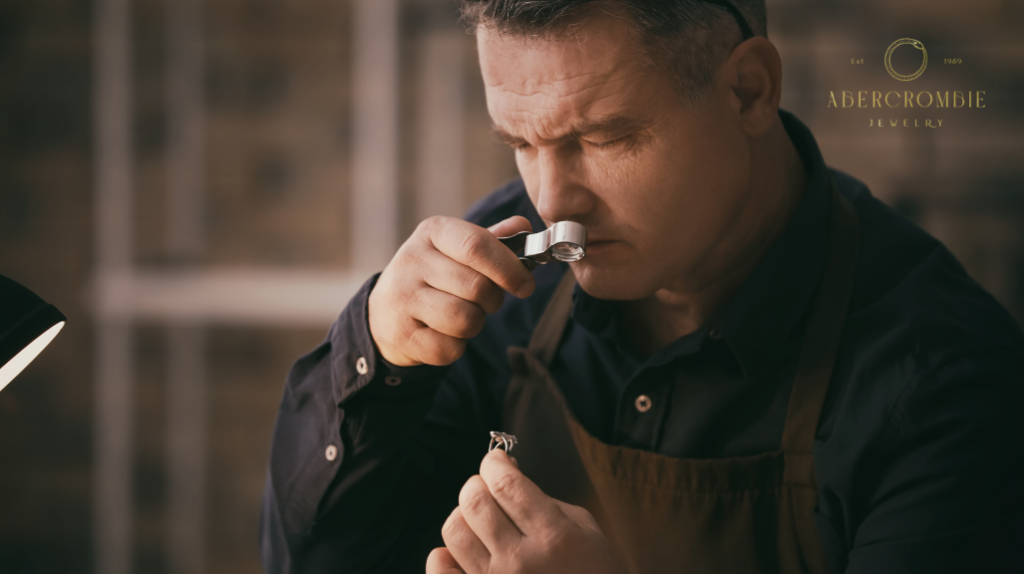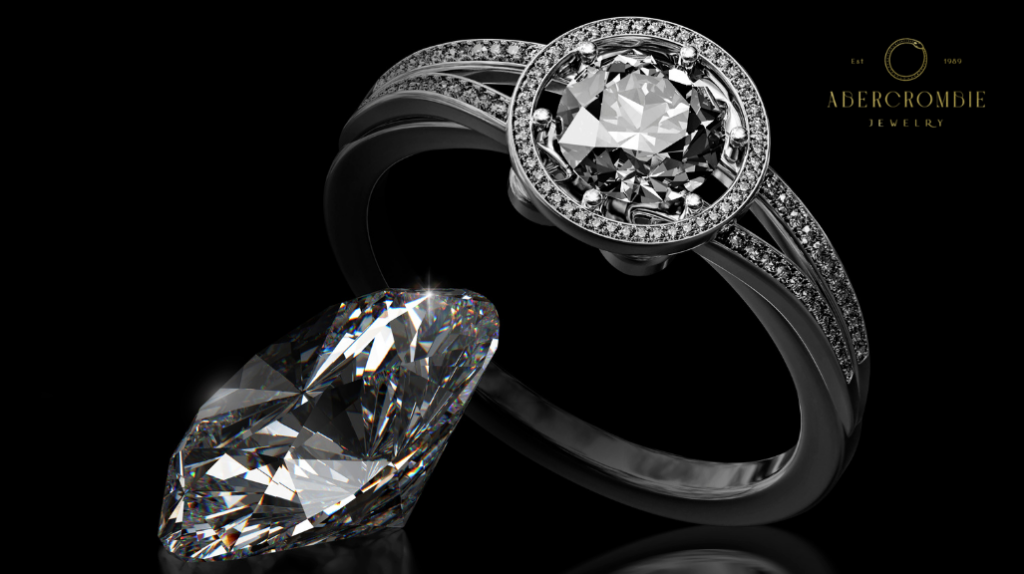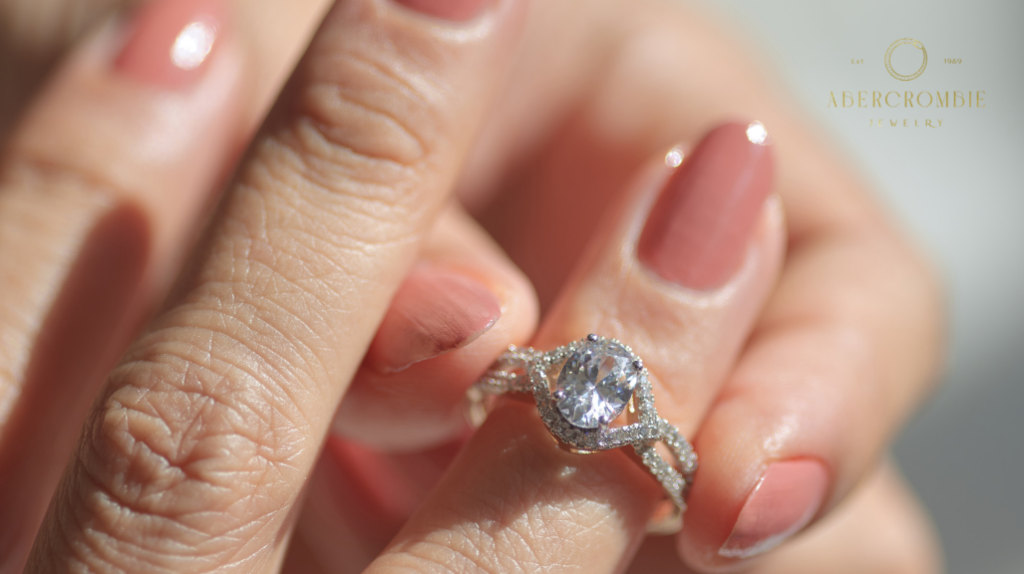- What Is a Diamond Appraisal?
- What Does a Diamond Appraisal Consist of?
- Other Factors Involved in Valuing a Diamond
- Why Should You Get Your Diamonds Appraised?
- What Are the Three Types of Diamond Appraisals?
- What's the Difference Between a Diamond Appraisal and Diamond Grading?
- When Should You Get a Diamond Ring Appraisal?
- An Antique Diamond Appraisal Helps Determine the Change In Your Diamond's Value
- Where Can You Get a Diamond Appraisal?
- The Bottom Line
- FAQs
Are you curious about what a diamond appraisal involves? Abercrombie Jewelry brings you a comprehensive guide to understanding the diamond appraisal process. Whether you’re looking to buy, sell, or insure your diamond jewelry, this guide will explain the importance and benefits of getting a professional diamond appraisal, ensuring you make informed decisions about your valuable gemstones.
Do you have any old diamonds lying around your house? You’re probably wondering how much they’re worth. Whether an old engagement ring or a pair of beautiful, sparkling earrings, your diamond should have value attached to it. Unfortunately, you can’t just tell the worth of a diamond by looking at it.
However, there is a way to determine the exact value of your diamond based on its condition and other impacting circumstances. This is known as a diamond appraisal. Whether you’re trying to sell your diamond, insure it, or are simply curious, the diamond appraisal process can be constructive.
If you want to know more about a diamond appraisal and other important and exciting details surrounding the process, keep reading!

What Is a Diamond Appraisal?
An appraisal is a way to determine the value of your diamond and comes in the form of a document or an official piece of paper. This document describes the main attributes of your diamond, such as carat, clarity, color, cut, and the diamond’s dimensions. If we take the cut of your diamond, for example, the appraisal indicates whether the diamond has an ideal cut or one that is excessively steep or wide.
However, it also provides information about the diamond’s setting, i.e., when it’s set in a ring or pendant. In such a situation, the appraisal also includes how the diamond and setting combine. It details the pendant, ring, earrings, or jewelry’s purity, weight, and design. Overall, you can expect to find everything regarding the diamond and setting in this document.
What Does a Diamond Appraisal Consist of?
Diamond certificates and appraisals refer to the four C’s: Color, cut, carat, and clarity. However, the purpose and way this information is included differs. When getting an appraisal, the four C’s are determined to assess and evaluate the monetary value of your diamond.
Therefore, you can expect to see the following factors in a diamond appraisal:
- Date
- Address
- Name of the buyer
- Certificate number
- Article number
- Invoice number
- A detailed description of the diamond, setting, and other jewels
- Color grade: This will range from D to Z, with Z representing a deep yellow color
- Weight of the diamond
- Cut: The shape and shape quality will either be “Poor” or “Ideal.”
- Clarity: The type of clarity and any identified impurities and the type of impurities
- The appraiser
- The retail value and the currency it was denoted in
This information is important as potential buyers or insurance companies will use it to determine whether the appraisal is accurate and trustworthy.
Other Factors Involved in Valuing a Diamond
Apart from the four C’s, there are numerous other factors appraisers consider when determining the value of a diamond, such as:
- Markup, brand recognition, and labor may impact your diamond’s value. However, it’s important to note that these factors are subjective. Therefore, different appraisers may value them differently. A brand name also can primarily affect its value. Lastly, the time, effort, method, and location are also known to have an impact on the diamond’s worth.
- The value of the metal setting: Most diamond jewelry includes precious metals, such as gold, silver, or platinum. These precious metals have different values, and the appraiser will add the value of the specific precious metal used to the overall appraisal.

Why Should You Get Your Diamonds Appraised?
There are different types of diamond appraisals designed for various purposes. This indicates that the appraised value will only be applicable in that particular situation. It’s essential to remember that it doesn’t convey the stone’s intrinsic value.
An assessment performed for insurance purposes is the most common type of diamond appraisal. A reliable estimate of a diamond’s value is required to purchase insurance.
The diamond appraisal will indicate to the insurance provider how much the diamond is worth if something unfortunate occurs, such as theft or loss. Additionally, the price you pay to the insurance company to cover the diamond in case of loss will also depend on the value of the appraisal.
A diamond may also be appraised to determine the value of inherited jewelry, for use in court cases such as ownership disputes or divorce, to sell the diamond, or even for tax purposes.
Next Blog: Do Diamond Rings Hold Their Value Over Time? What You Should Know
What Are the Three Types of Diamond Appraisals?
While you might think the appraisal process is straightforward, it can get slightly more complex. There isn’t just one type of appraisal; there are three for you to choose from. Let’s look at them in more detail so you can decide on the best option for you.
A Fair Market Value Appraisal
Fair market value appraisals estimate the potential price you’ll get for a diamond if you put it up for sale. Additionally, it can determine the taxable value of a diamond ring or other pieces of diamond jewelry. Therefore, if you need help determining an appropriate selling price for your diamond, this jewelry appraisal is recommended.
A Replacement Value Appraisal
A replacement value appraisal gives you the market value of a diamond in the event of theft, loss, or any other circumstance necessitating its replacement. Typically, you obtain this to file an insurance claim if an incident gives rise to a claim for a lost diamond. This is the most common type of diamond appraisal.

A Comparable Replacement Value Appraisal
When it comes to particular diamonds that are special or rare in any other manner or that have historical worth, a comparable replacement value evaluation is performed. This assessment differs from a typical replacement value appraisal in that such distinctive diamonds typically cannot be replaced because of their unique features or value. However, you will want to try not to lose or get rid of a particular or rare diamond, as these can be pretty sentimental or worth a lot of money.
What’s the Difference Between a Diamond Appraisal and Diamond Grading?
Diamond grading is a complete assessment of a diamond and its characteristics, including carat, cut, color, and clarity (the “four C’s”). In contrast, diamond appraisal is the process of attributing a monetary value to the diamond for a particular reason, such as a divorce, resale, insurance, or tax.
Professionals with the necessary credentials grade diamonds in well-known gemological facilities such as GIA and GSI. According to the grading carried out by these authorized labs, the market places value on diamonds.
The market worth of your diamond can be approximated if you know its four characteristics. Overall, the most transparent, precise, and objective tool you have to figure out how much the market is willing to pay for your diamond at a certain point in time is through a diamond grading report.
When Should You Get a Diamond Ring Appraisal?
Unless you purchased your ring with an appraisal, you should consider getting one as soon as you get the piece. This ensures you can get the diamond ring insured as soon as possible.
Diamond ring appraisals should be done every five years because the cost and value of diamonds tend to change over the years. Therefore, your existing appraisal might be outdated and incorrect. You want to ensure that if something were to happen to your ring, you could get the entire current market/ replacement value of the diamond from your insurer.

An Antique Diamond Appraisal Helps Determine the Change In Your Diamond’s Value
Diamond buyers and sellers should know that diamonds tend to change in value over time. While the value of some diamond pieces may increase, other diamond jewelry may depreciate.
An antique diamond appraisal is highly recommended, as this can help you determine whether you have a rare diamond. This way, if you have diamond jewelry you appreciate, you can make long-term decisions and decide to keep your diamond and potentially pass it down to your family.
Suppose you have a depreciating diamond, on the other hand. In that case, you’ll get the clarity you were looking for and won’t waste time believing you have a precious diamond.
Where Can You Get a Diamond Appraisal?
If you’re interested in getting your jewelry appraised, there are many places to consider. Local jewelers are the most common option and should have the knowledge and tools to conduct a thorough diamond appraisal.
However, suppose you’re looking for a credible appraisal and are interested in selling your diamond. In that case, you might want to consider getting a grading from a more recognized, reputable, and worldwide organization, such as:
- AGS: American Gem Society
- GIA: Gemological Institute of America
- IGI: International Gemological Institute
- EGL: European Gemological Laboratory
The Bottom Line
Do you need to get your diamond appraised? There are a variety of reasons you may need a diamond appraisal. However, if you’re interested in selling your diamond, the best way to determine your diamond’s actual market value is to have an official diamond evaluation with a diamond grading report. There are many convenient and accurate ways for diamond sellers and buyers to appraise their diamonds and determine the value of these precious pieces.

